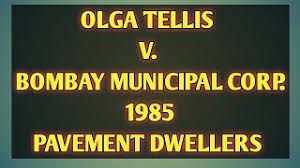27 Apr 2022 Olga Tellis Vs Bombay Municipal Corporation 1985

Olga Tellis Vs Bombay Municipal Corporation 1985 – Today Current Affairs
- Recently, a Constitution Bench judgment of the Supreme Court in Olga Tellis vs Bombay Municipal Corporation 1985, held that footpath residents in the Jahangirpuri (Delhi) case, different from encroachers, could play an important role in subsequent decisions.
Today Current Affairs
Questions raised before the Supreme Court:
Background:
- The case began in 1981 when the State of Maharashtra and the Bombay Municipal Corporation decided that footpaths and slum dwellers in the city of Bombay should be evicted and “deported to their place of origin or to areas outside the city of Bombay”.
The question of right to life of the people living on the footpath : The Hindu Analysis
- One of the main questions was whether eviction of a pavement dweller was a part of the Constitution. Art. 21 of their right to guaranteed livelihood.
- According to Article 21, “No person shall be deprived of his life or personal liberty except according to procedure established by law”.
- There are about 20 million people living on footpaths in India.
Question of prior approval for removal of encroachment : The Hindu Analysis
- The Constitution Bench was also asked to determine whether the provisions contained in the Bombay Municipal Corporation Act, 1888, are arbitrary and unreasonable and allow removal of encroachments without prior notice.
Question on encroachment : The Hindu Analysis
- The Supreme Court also decided to examine the question whether it would be constitutionally inappropriate to mark footpath occupants as trespassers.
Decision of the Supreme Court in Olga Tellis vs Bombay Municipal Corporation, 1985 : The Hindu Analysis
- In Olga Tellis vs Bombay Municipal Corporation judgment in 1985, the Court held that it is unconstitutional to evict pedestrians by force without reason and without giving them an opportunity to explain.
- It is a violation of their Right to Livelihood.
- The court had taken strong objection to the authorities considering the occupants of the footpath as only trespassers.
- “They (pavement dwellers) mostly find places to live in filthy or marshy places due to their very poor economic condition.
State government’s defence : The Hindu Analysis
- Question of Estoppel: The state government and the corporation protested that the people living on the footpath should be stopped.
- Estoppel is a judicial instrument by which a court can ‘prevent’ a person from making a claim.
- The statute can bar someone from claiming that the hut built by him on the footpath cannot be demolished because of his right to livelihood.
- Right to Public Way: They cannot claim any fundamental right to encroach on footpaths or public roads and build huts as people have the right to move on those roads.
Recent judgment of Supreme Court:
On the Estoppel : The Hindu Analysis
- The court rejected the government’s argument for the constitution, saying that “there can be no constitution against the constitution.” ,
- The court said that the right to life of the people living on the footpath is at stake.
On Right to Livelihood : The Hindu Analysis
- The right to livelihood is an “integral component” of the right to life.
- If the right to livelihood is not considered as part of the constitutional right to life, then the easiest way to deprive a person of his right to life would be to deprive him of his means of livelihood.
On prior notice : The Hindu Analysis
- The second question is whether the provisions of the law allowing statutory authorities to remove encroachments without prior notice were arbitrary.
- Such rights are designed to operate as an ‘exception’, not a “general rule”.
- The eviction process should be in favor of procedural safeguards that follow the natural principles of justice such as giving the other party an opportunity of being heard.
- The right to be heard provides an opportunity for victims to participate in the decision-making process and to speak with dignity.
Trespass : The Hindu Analysis
- The court has taken strong objection to the authorities considering the people living on the footpath as trespassers.
- The apex court ruled that footpath dwellers live on “extremely dirty footpaths” and not with the intention of humiliating, intimidating or harassing anyone.
- They live on the sidewalk and earn because they have “little care in the city and no house to live in.”


No Comments